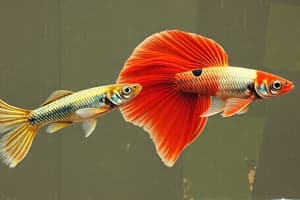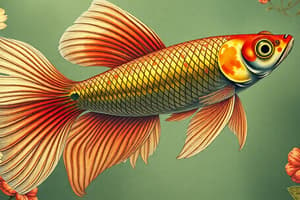Podcast
Questions and Answers
What is the significance of male guppies having bright colors despite being preyed upon?
What is the significance of male guppies having bright colors despite being preyed upon?
Bright colors in male guppies may attract mates, providing reproductive advantages despite the increased risk of predation.
How did John Endler contribute to the study of guppy coloration?
How did John Endler contribute to the study of guppy coloration?
John Endler studied guppies in Trinidad and documented variations in coloration related to different stream environments and predator distribution.
What correlation did Endler observe regarding guppy colors and their habitats?
What correlation did Endler observe regarding guppy colors and their habitats?
Endler found a strong correlation between guppy coloration and the size and color of gravel in their habitats, as well as predator presence.
What does the variety of guppy coloration suggest about their evolutionary pressures?
What does the variety of guppy coloration suggest about their evolutionary pressures?
Why might camouflage be an advantageous trait in guppies?
Why might camouflage be an advantageous trait in guppies?
What observations led Endler to investigate guppy coloration further?
What observations led Endler to investigate guppy coloration further?
Why might male guppies with dull colors be more common downstream?
Why might male guppies with dull colors be more common downstream?
What role do mating strategies play in the coloration of male guppies?
What role do mating strategies play in the coloration of male guppies?
What hypothesis did Endler form regarding guppy color variation?
What hypothesis did Endler form regarding guppy color variation?
What environmental characteristics differ among the three river sections studied?
What environmental characteristics differ among the three river sections studied?
How does the predation risk differ in the three river sections?
How does the predation risk differ in the three river sections?
Which type of guppy is most successful in this environment?
Which type of guppy is most successful in this environment?
What types of predators are found in the deep pool section?
What types of predators are found in the deep pool section?
Which guppy color variants were classified during the experiment?
Which guppy color variants were classified during the experiment?
What advantages does this common phenotype provide in this environment?
What advantages does this common phenotype provide in this environment?
What is the significance of the pool behind the natural dam for guppy populations?
What is the significance of the pool behind the natural dam for guppy populations?
How does the guppy success in this environment compare to Site 1?
How does the guppy success in this environment compare to Site 1?
Why are small fish the only inhabitants of the shallow pool?
Why are small fish the only inhabitants of the shallow pool?
What factors might contribute to the success of flashy guppies in this environment?
What factors might contribute to the success of flashy guppies in this environment?
Why might flashy guppies not be as successful in Site 1?
Why might flashy guppies not be as successful in Site 1?
In what way might guppy coloration be an adaptive trait?
In what way might guppy coloration be an adaptive trait?
Which type of guppy is most successful in the river site environment?
Which type of guppy is most successful in the river site environment?
What advantage does the brightest phenotype have in this environment?
What advantage does the brightest phenotype have in this environment?
What is the total guppy population recorded at the River Site?
What is the total guppy population recorded at the River Site?
How many generations of guppies were examined in the experiment?
How many generations of guppies were examined in the experiment?
What population percentage does the drab guppy represent?
What population percentage does the drab guppy represent?
Why might the drabbest guppy phenotype have the lowest population percentage?
Why might the drabbest guppy phenotype have the lowest population percentage?
What is the significance of taking data over 265 weeks?
What is the significance of taking data over 265 weeks?
What does the term 'relative frequency' mean in the context of guppy populations?
What does the term 'relative frequency' mean in the context of guppy populations?
What might be the ecological implications of having 30 rivulus predators?
What might be the ecological implications of having 30 rivulus predators?
How does the color of guppies relate to evolutionary success in this environment?
How does the color of guppies relate to evolutionary success in this environment?
Which type of guppy demonstrates the highest success in the studied environment?
Which type of guppy demonstrates the highest success in the studied environment?
What is the ecological advantage of the common phenotype of colorful males in this environment?
What is the ecological advantage of the common phenotype of colorful males in this environment?
How do the results from the current site differ from Sites 1 and 2?
How do the results from the current site differ from Sites 1 and 2?
Why did Endler choose to wait a specific length of time before collecting data in the guppy study?
Why did Endler choose to wait a specific length of time before collecting data in the guppy study?
What might cause variations in coloration among drabbest male guppies in different river areas?
What might cause variations in coloration among drabbest male guppies in different river areas?
What can be concluded about male guppies' color variations when there are very few predators present?
What can be concluded about male guppies' color variations when there are very few predators present?
How does the presence of many predators influence the coloration that is most advantageous for male guppies?
How does the presence of many predators influence the coloration that is most advantageous for male guppies?
What type of claim could be made about guppy coloration with a moderate number of predators?
What type of claim could be made about guppy coloration with a moderate number of predators?
What evidence would support the claim of drabbest males being fit when few predators are present?
What evidence would support the claim of drabbest males being fit when few predators are present?
Why is reasoning important when discussing claims about guppy coloration?
Why is reasoning important when discussing claims about guppy coloration?
How might moderate predator levels affect guppy mating strategies?
How might moderate predator levels affect guppy mating strategies?
In what way does the concept of natural selection relate to the color variations of male guppies?
In what way does the concept of natural selection relate to the color variations of male guppies?
What role does environmental predation play in shaping the coloration of male guppies?
What role does environmental predation play in shaping the coloration of male guppies?
Flashcards
Guppy Habitat Types
Guppy Habitat Types
Different sections of a river (deep pool, pool behind dam, shallow pool) have unique environmental characteristics that affect guppies.
Guppy Predator Variation
Guppy Predator Variation
Different river sections have different predator types and numbers which affect the guppies.
Predation Risk
Predation Risk
The risk of being eaten by a predator.
Deep Pool Guppies
Deep Pool Guppies
Signup and view all the flashcards
Pool Behind Dam Guppies
Pool Behind Dam Guppies
Signup and view all the flashcards
Shallow Pool Guppies
Shallow Pool Guppies
Signup and view all the flashcards
Guppy Color Variants
Guppy Color Variants
Signup and view all the flashcards
Evolutionary Biology Discovery
Evolutionary Biology Discovery
Signup and view all the flashcards
Guppy coloration variation
Guppy coloration variation
Signup and view all the flashcards
Endler's research
Endler's research
Signup and view all the flashcards
Predator effect on coloration
Predator effect on coloration
Signup and view all the flashcards
Guppy adaptation
Guppy adaptation
Signup and view all the flashcards
Stream locations and coloration
Stream locations and coloration
Signup and view all the flashcards
Evolutionary biologist
Evolutionary biologist
Signup and view all the flashcards
Coloration as a liability
Coloration as a liability
Signup and view all the flashcards
Most successful guppy type
Most successful guppy type
Signup and view all the flashcards
Success reason
Success reason
Signup and view all the flashcards
Phenotype advantage
Phenotype advantage
Signup and view all the flashcards
Site 1 comparison
Site 1 comparison
Signup and view all the flashcards
Reason for difference
Reason for difference
Signup and view all the flashcards
Guppy Success
Guppy Success
Signup and view all the flashcards
Study Duration
Study Duration
Signup and view all the flashcards
Guppy Color Variation
Guppy Color Variation
Signup and view all the flashcards
Translocated Guppy Fitness
Translocated Guppy Fitness
Signup and view all the flashcards
Claims Analysis
Claims Analysis
Signup and view all the flashcards
Most successful guppy color
Most successful guppy color
Signup and view all the flashcards
Guppy population
Guppy population
Signup and view all the flashcards
Predator type
Predator type
Signup and view all the flashcards
Predation pressure environment
Predation pressure environment
Signup and view all the flashcards
Number of generations
Number of generations
Signup and view all the flashcards
Brightest guppy percentage
Brightest guppy percentage
Signup and view all the flashcards
Drab Guppy Percentage
Drab Guppy Percentage
Signup and view all the flashcards
Study Site
Study Site
Signup and view all the flashcards
Data Analysis
Data Analysis
Signup and view all the flashcards
Fitness in Guppy Evolution
Fitness in Guppy Evolution
Signup and view all the flashcards
Predator Presence Impact
Predator Presence Impact
Signup and view all the flashcards
Low Predation Environment
Low Predation Environment
Signup and view all the flashcards
High Predation Environment
High Predation Environment
Signup and view all the flashcards
Moderate Predation
Moderate Predation
Signup and view all the flashcards
Natural Selection in Guppies
Natural Selection in Guppies
Signup and view all the flashcards
Adaptations for Survival
Adaptations for Survival
Signup and view all the flashcards
Study Notes
The Flashy Guppy Data Analysis
- Guppies exhibit variations in color and size, particularly among males, even within the same stream.
- These variations correlate with the presence and types of predators and the environment.
- John Endler's research demonstrated a connection between guppy coloration and predator presence: Bright coloration is a disadvantage in areas with many predators, but an advantage in areas where predators are less common.
- Guppies in areas with fewer predators tend to exhibit brighter colors, while those in areas with more predators are drab.
- Predator types and their prevalence affects guppy coloration.
Guppy Habitats
- Guppies inhabit Trinidad's Aripo River.
- River sections differ in predator types and densities.
- Differences in predator populations influence the types of guppies that thrive.
- Deep pools have many predators, while shallow pools have fewer.
Guppy Color Variants
- Endler's study classified guppies into four color variants: Brightest, Bright, Drab, and Drabbest.
- Variations observed in different sections of the river.
- The study focused on male guppy coloration.
Predator Types and Sizes
- Predators observed in the study included pike cichlids, blue acara, and rivulus.
- Pike cichlids, blue acara, and rivulus vary in size, affecting the success of different guppy color variations in different sections of the river.
Experimental Site Data
- Data was collected on coloration and the presence of predators in different river sections over time.
- Data included the number of guppies of each color variant in different sections of the river.
- Number of generations, weeks of observation, predators, and guppy populations varied.
Reflection Questions
- The most successful guppy color type is influenced by predation pressures.
- Color helps avoid predation when predation pressure is high.
Studying That Suits You
Use AI to generate personalized quizzes and flashcards to suit your learning preferences.


